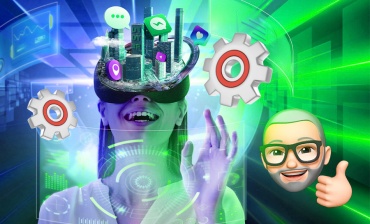Workplaces Impacted by Technology of Simulated Reality Similar to Matrix

Being a part of a virtual reality, like the Matrix from the science fiction movie of the same name from 1999, has drawn a lot of interest recently. This article explores the idea in depth, looks at its implications for reality, and speculates on how it might affect current workplace incentive schemes.
With the release of The Matrix, the Wachowski siblings’ film, the world became fascinated with the intriguing notion that we unwittingly reside in a simulation that was created by computers and ruled by sentient beings. This intriguing notion has sparked philosophical discussion and debate on a variety of hot-button issues, including the nature of reality, consciousness, and how we perceive the world.
Despite its fictional origins, the idea of living in a simulation akin to The Matrix has become popular in a number of academic and philosophical circles. The Simulation Hypothesis, which holds that it is more likely than not that we are living in a simulation, has even been advanced by some researchers and intellectuals, including Oxford philosopher Nick Bostrom. It’s critical to keep in mind that this hypothesis is still merely speculative and does not have any evidence from actual research to support it.
Even though the idea that we are living in a virtual reality is still up for debate, it is fascinating to consider how this theory might affect our everyday lives and, in particular, our workplaces. A “Matrix game,” in which players try to succeed in a virtual world, might be compared to workplace incentive programs, for example.
Modern workplace reward systems frequently rely on incentives, recognition, and motivation to encourage high performance and engagement in workers. As a result of these initiatives, employees are encouraged to work in a competitive environment where they are constantly challenged to do better. In this case, it could be argued that workplace incentive programs resemble a game in which employees compete to outperform their peers and achieve personal success.
The Matrix or virtual reality as a lens through which to view workplace incentive systems is probably oversimplified. Although some components of these systems might appear competitive or like “game-playing,” they are ultimately based on real social and economic structures. Employee success goals and motivations are based on genuine needs and desires, such as financial security, career advancement, and personal fulfillment.
In addition, the Matrix concept is more of a philosophical exercise than a direct explanation of how reality operates. In this sense, it’s possible that the Matrix and workplace incentive programs are more metaphorical than literal comparisons. While it is intriguing to speculate about potential connections between a virtual reality and our workplaces, it is crucial to comprehend the practical and real-world effects that these systems will have on employee well-being, engagement, and productivity.
In conclusion, the idea of living in a virtual reality akin to The Matrix offers an intriguing thought experiment that has sparked significant philosophical discussions and debates. There is currently no concrete evidence, though, to support the notion that our reality is a simulation. Workplace reward systems can be thought of as “games” in terms of motivation and incentives, but not in the sense of a Matrix-style simulation. Ending with a focus on the specific needs and wellbeing of employees, understanding and improving workplace reward systems should remain grounded in the real-world context.
Author: Pooyan Ghamari, Swiss Economist
Comments are closed.